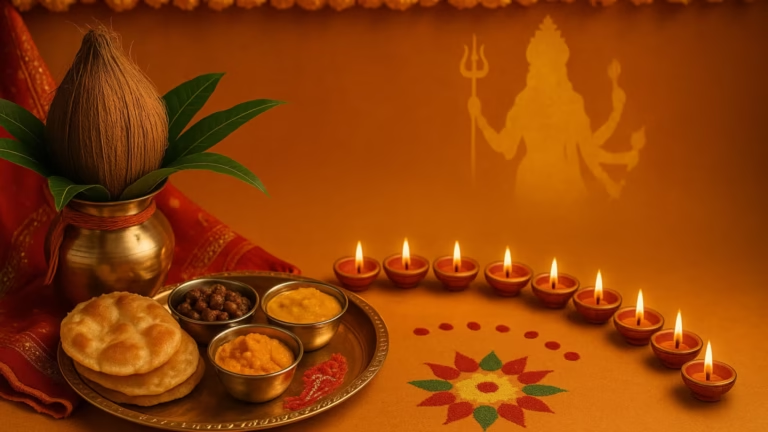According to the Hindu calendar, when there is no Sankranti (the Sun’s transition from one zodiac to another) during a lunar month, that month is called “Adhik Maas”. It is also referred to as “Malmas” because it is different from regular months and certain auspicious tasks are considered forbidden during this period.
Table of Contents
When does this month occur?
Adhik Maas occurs approximately every 32 months, 16 days, and 8 hours. The main reason for this is the difference in the movements of the lunar and solar months.
Why does Adhik Maas come every three years?
The Hindu calendar has two systems — the lunar calendar (based on the moon’s cycles) and the solar calendar (based on the sun’s movement). A lunar year is about 354 days, while a solar year is about 365 days. To adjust this 11-day annual difference, an extra month is added approximately every three years, known as Adhik Maas.
Read Also: श्रावण सोमवार की पूजा कैसे करें? जानिए संपूर्ण जानकारी, विधि और महत्व
Astronomical and Mathematical Basis.
Difference between Lunar and Solar Months
- Lunar Month: From one full moon to the next or one new moon to the next.
- Solar Month: The time it takes for the sun to move from one zodiac sign to the next.
A lunar year is 354 days, and a solar year is 365 days. This results in an 11-day difference each year, which accumulates to a full month in approximately three years. This extra month is added to maintain the balance in the calendar.
Its Role in Panchang Calculations
The Panchang (Hindu almanac) aims to guide life in harmony with time and dharma. This special month helps maintain this balance so that all festivals align with their proper seasons.
Importance in the Hindu Calendar
This month holds deep religious importance. It is dedicated to Lord Vishnu and is considered highly auspicious for devotion, austerity, chanting, fasting, storytelling, and charity.
Other Names:
- Malmas: Initially considered inauspicious due to the absence of Sankranti.
- Purushottam Maas: Lord Vishnu blessed this month with His name and divine grace.
Why is Adhik Maas called ‘Purushottam Maas’?
Adhik Maas is regarded as the special month of Lord Vishnu because “Purushottam” is one of His revered names. A fascinating story about this is found in the Puranas.
It is said that in ancient times, sages assigned each lunar month to a deity. However, when this additional lunar month appeared due to calendrical adjustments, no deity claimed it. Since it existed to balance the solar and lunar years, no god was willing to accept it.
The sages then approached Lord Vishnu and requested Him to take charge of this month and bless it. Lord Vishnu graciously accepted and granted it His name — “Purushottam Maas.” Thus, this month became known as both Malmas and Purushottam Maas.
Religious Verse:
“Yah Purushottam Maase bhaktyā mām samprapūjayet,
Sa samasta-pāpa-vinir-muktaḥ mama sāyujyam avāpnuyāt”
Meaning: One who worships Me with devotion during Purushottam Maas becomes free from all sins and attains union with Me.
The Mythological Story of Adhik Maas
There is a beautiful and inspiring tale related to Purushottam Maas found in the Puranas, associated with the slaying of the demon king Hiranyakashyap.
Hiranyakashyap performed intense penance to please Lord Brahma and requested the boon of immortality. Since immortality could not be granted, Brahma asked him to request another boon. Cleverly, Hiranyakashyap asked that he could not be killed by any man, woman, animal, god, or demon; not during the day or night; not by any weapon or tool; and not indoors or outdoors.
Empowered by this boon, he grew arrogant and declared himself to be God, suppressing devotion and righteousness. When his tyranny crossed limits, Lord Vishnu incarnated during Adhik Maas as Narasimha — half-man, half-lion.
At dusk (neither day nor night), on the threshold (neither indoors nor outdoors), using His claws (neither weapon nor tool), Lord Narasimha tore open Hiranyakashyap’s chest and restored dharma. This further elevated the spiritual glory of purushottam Maas.
Which activities are considered auspicious during This Month?
Importance of Accruing Virtue:
Religious activities performed during Adhik Maas are believed to yield multiplied spiritual benefits.
Relation to Liberation and Devotion:
This month is ideal for attaining moksha (liberation), inner purification, and spiritual elevation.
What should be done during Adhik Maas?
Recommended Practices:
- Spiritual Readings: Recite Srimad Bhagavatam, Ramayana, Gita, and Vishnu Purana.
- Fasting: Especially on Mondays, Ekadashi, and Purnima.
- Bhajans and Kirtans: Chant the names of Lord Vishnu.
- Charity: Donate food, clothes, cows, gold, money, and knowledge.
- Pilgrimage: Visit sacred sites.
- Special Mantra Chanting: “Om Namo Bhagavate Vasudevaya”
What should not be done?
Prohibited Activities:
- Marriage: Not considered an auspicious time for weddings.
- Mundan (First Haircut): Not recommended for children.
- Housewarming or Construction: Avoided during this period.
These restrictions exist because this month is primarily meant for devotion and penance.
Religious and Mythological Significance
Mentions in Puranas:
- Skanda Purana: Describes Adhik Maas as “Purushottam Maas.”
- Brahma Purana: States that this month is especially dear to Lord Vishnu, and acts of virtue performed during this time yield immense rewards.
Lord Vishnu’s Association:
Lord Vishnu personally bestowed His name and grace upon this month, making it supremely sacred.
Scientific and Practical Perspective
Balancing the Lunar-Solar Calendar:
Purushottham Maas is a brilliant example of astronomical wisdom in the Hindu calendar system. It ensures seasonal alignment of festivals.
Social Acceptance:
Both rural and urban communities celebrate this month with devotion — through storytelling, kirtans, fasts, and group prayers.
Frequently Asked Questions (FAQs)
Q1: How often does Adhik Maas occur?
A: Once every 32.5 months.
Q2: Can marriages be conducted in this month?
A: No, it is considered inauspicious for weddings and similar ceremonies.
Q3: What should one do during purushottam Maas?
A: Observe fasts, read sacred texts, chant mantras, give charity, and worship Lord Vishnu.
Q4: Why is it called Purushottam Maas?
A: Because Lord Vishnu accepted and sanctified this month with His own name.
Summary:
This Hindu lunar leap month is not merely a calendrical adjustment but a profound spiritual opportunity — for introspection, purification, and divine devotion. It stands as a reminder that time, when aligned with dharma and bhakti, becomes a path to liberation.
Those who take spiritual vows during this month and follow the path of devotion are surely blessed by Lord Vishnu and attain His eternal grace.
Whatsapp Channel Link :–https://whatsapp.com/channel/0029VbB0KvuIHphFXKcwyq3B
Click Hrere To Read In English: अधिक मास क्या है ? कब और क्यों आता है?



